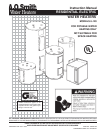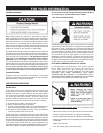
7
INSTALLING THE NEW WATER HEATER
WATER PIPING
HOTTER WATER CAN SCALD:
Water heaters are intended to produce hot water. Water heated to a
temperature which will satisfy space heating, clothes washing, dish
washing, cleaning and other sanitizing needs can scald and permanently
injure you upon contact. Some people are more likely to be permanently
injured by hot water than others. These include the elderly, children,
the infirm, or physically/mentally disabled. If anyone using hot water in
your home fits into one of these groups or if there is a local code or
state law requiring a certain temperature water at the hot water tap,
then you must take special precautions. In addition to using the lowest
possible temperature setting that satisfies your hot water needs, a
means such as a mixing valve should be used at the hot water taps
used by these people or at the water heater. Valves for reducing point
of use temperature by mixing cold and hot water are also available.
Consult a Qualified Installer or Service Agency. Follow manufacturer’s
instructions for installation of the valves. Before changing the factory
setting on the thermostat, read the “Temperature Regulation” section in
this manual.
This water heater shall not be connected to any heating systems or
component(s) used with a non-potable water heating appliance.
Use properly sized water heaters for spa or hot tub use.
Toxic chemicals, such as those used for boiler treatment shall not
be introduced into this system.
Water supply systems may, because of such events as high line
pressure, frequent cut-offs, the effects of water hammer among others,
have installed devices such as pressure reducing valves, check
valves, back flow preventers, etc. to control these types of problems.
When these devices are not equipped with an internal by-pass, and
no other measures are taken, the devices cause the water system to
be closed. As water is heated, it expands (thermal expansion) and
closed systems do not allow for the expansion of heated water.
The water within the water heater tank expands as it is heated and
increases the pressure of the water system. If the relieving point of
the water heater’s temperature-pressure relief valve is reached, the
valve will relieve the excess pressure. The temperature-pressure
relief valve is not intended for the constant relief of thermal
expansion. This is an unacceptable condition and must be corrected.
It is recommended that any devices installed which could create a
closed system have a by-pass and/or the system have an expansion
tank or device to relieve the pressure built by thermal expansion in
the water system. Expansion tanks are available for ordering through
a local plumbing contractor.
Contact the local water supplier and/or
a service agency for assistance in controlling these situations.
3. The water heater should be located so it is not subject to physical
damage by moving vehicles or area flooding.
Installation of the water heater must be accomplished in such a
manner that if the tank or any connections should leak, the flow
will not cause damage to the structure. For this reason, it is not
advisable to install the water heater in an attic or upper floor.
When such locations cannot be avoided, a suitable drain pan
should be installed under the water heater. Drain pans are
available from your local plumbing contractor. Such a drain pan
must have a minimum length and width of at least 2 inches (51
mm) greater that the water heater dimensions and must be piped
to an adequate drain.
Water heater life depends upon water quality, water pressure and the
environment in which the water heater is installed. Water heaters are
sometimes installed in locations where leakage may result in property
damage, even with the use of a drain pan piped to a drain. However,
unanticipated damage can be reduced or prevented by a leak detector
or water shut-off device used in conjunction with a piped drain pan.
These devices are available from some plumbing supply wholesalers
and retailers, and detect and react to leakage in various ways:
• Sensors mounted in the drain pan that trigger an alarm or turn off
the incoming water to the water heater when leakage is detected.
• Sensors mounted in the drain pan that turn off the water supply to
the entire home when water is detected in the drain pan.
• Water supply shut-off devices that activate based on the
water pressure differential between the cold water and hot
water pipes connected to the water heater.
INSULATION BLANKETS
Insulation blankets are available to the general public for external
use on electric water heaters but are not necessary with this product.
The purpose of an insulation blanket is to reduce the standby heat
loss encountered with storage tank heaters. Your water heater meets
or exceeds the National Appliance Energy Conservation Act
standards with respect to insulation and standby loss requirements,
making an insulation blanket unnecessary.
Should you choose to apply an insulation blanket to this heater, you
should follow these instructions below. Failure to follow these
instructions can result in fire, serious personal injury, or death.
•
Do not cover the temperature and pressure relief (T & P) valve
with an insulation blanket.
•
Do not cover the instruction manual. Keep it on the side of the
water heater or nearby for future reference.
•
Do obtain new warning and instruction labels for placement on
the blanket directly over the existing labels.


















